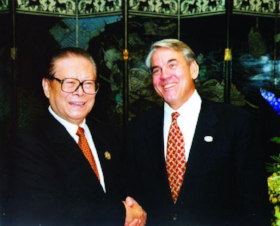Sometimes impatient business people get involved with nonprofits. The nonprofit’s goals may seem remote, the results unachievable. But I’ve learned that patience and persistence can produce powerful results.
In 1997 I traveled with Applied’s diverse Asia-Pacific team down the Yangtze River to China’s Three Gorges Dam. Construction on the dam had begun in 1994. It is now the world’s largest power station, designed in part to help control the floods that had killed many people along the path of the Yangtze River through the centuries.
Unfortunately, as I learned, the consequences of the dam on the health of the river ecosystem had been substantial. The dam itself created a reservoir for sediment and organic and industrial waste that no longer continued downstream, destroying water quality. Also, the project displaced over a million people and flooded dozens of cities, towns and villages where no efforts to remove toxins from foundries and other activities were conducted prior to the flooding.
As I looked at the murky river, the deforested slopes, and the many villages black from decades of burning coal and wood, the problems China faced seemed insurmountable. I became convinced that I had to do my part to help the world begin to repair damage from large-scale projects and haphazard development. This wouldn’t be easy; I would have to be patient and persistent.
In 2003 Hank Paulson, the CEO of Goldman Sachs, asked me to join The Nature Conservancy (TNC) Asia Pacific Council of business leaders. He and Lee Kuan Yew, the Prime Minister of Singapore, had created the council to advise TNC management in Asia. The council made a trip to Hong Kong and we discussed how TNC had the opportunity to work with the Chinese on a plan to protect large wilderness areas and improve the environment. Our work had begun.
TNC would continue to work with China to help it improve water management and dam-building strategies. This is very important since the Chinese will build most of the dams worldwide in the coming decades. A “Great Rivers Partnership” was formed around the Yangtze, the Mississippi, and the Pantanal in South America. This has led to improvements in dam building and freshwater river strategies in China, the U.S. and in Brazil and Colombia.
The conservation news from China these days is promising. I read recently that Stanford University ecologist Gretchen Daily says that China’s environmental conservation efforts are making a positive impact. “In the face of a deepening environmental crisis,” she says, “China has become very ambitious and innovative in its conservation science and policies and has implemented them on a breathtaking scale.”
While perhaps not as significant as the broader environmental programs, China’s conservation efforts have pulled the Giant panda off the endangered species list.
The Nature Conservancy remains extremely active in China, working to find solutions that allow China to develop and protect the full spectrum of its biodiversity, from pandas to people.
My experiences on TNC’s Asia Pacific Council gave me an entirely new and important perspective on conservation and environmental issues in Asia, and it allowed me to stay engaged in the rising importance of the region. It proved the value of patience and persistence.

In 1997, I traveled with Applied’s diverse Asia-Pacific team down the Yangtze River to China’s Three Gorges Dam.
Please Comment Below
How have you learned to be more patient and persistent in achieving your goals?

